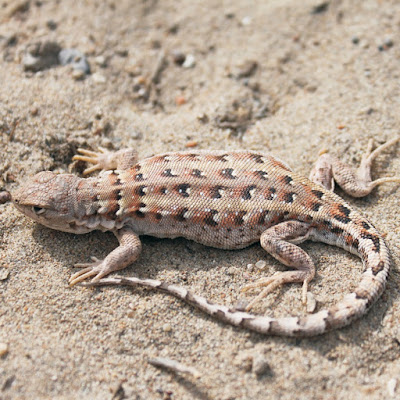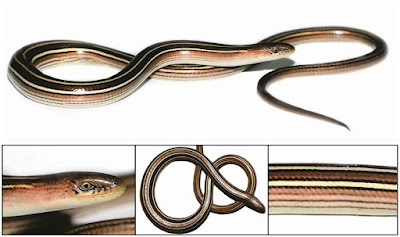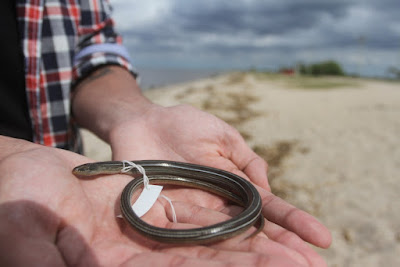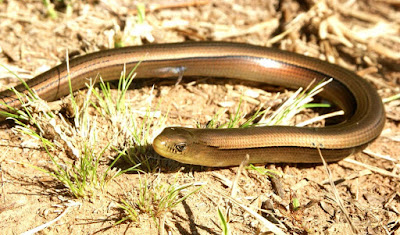[Most Recent Entries] [Calendar View]
Thursday, December 7th, 2017
| Time | Event | ||||
| 10:44a | [Herpetology • 2017] Liolaemus tirantii & L. calliston • New Species of Liolaemus (Squamata, Liolaemini) of the Liolaemus donosobarrosi clade from northwestern Patagonia, Neuquén Province, Argentina
Abstract Two new species of the Liolaemus donosobarrosi clade are described. Liolaemus tirantii sp. nov. and Liolaemus calliston sp. nov. differ from other members of their clade by a combination of coloration characters, morphometric and molecular traits. Liolaemus tirantii sp. nov. is known from three localities separated only a few kilometers from each other and Liolaemus calliston sp. nov. is known only from the type locality. Both species inhabit a region strongly impacted by oil and gas extraction but their conservation status is unknown. Keywords: Reptilia, Argentina, Liolaemidae, Liolaemus tirantii sp. nov., Liolaemus calliston sp. nov., Liolaemus donosobarrosi clade, Northwestern Patagonia Luciano Javier Avila, Cristian Hernán Fulvio Perez, Ignacio Minoli, Cintia Debora Medina, Jack W. Jr. Sites and Mariana Morando. 2017. New Species of Liolaemus (Reptilia, Squamata, Liolaemini) of the Liolaemus donosobarrosi clade from northwestern Patagonia, Neuquén Province, Argentina. Zootaxa. 4362(4); 535–563. DOI: 10.11646/zootaxa.4362.4.4 | ||||
| 12:44p | [Herpetology • 2017] Ophiodes enso • A New and Microendemic Species of Ophiodes Wagler, 1828 (Sauria: Diploglossinae) from the Lagoa dos Patos Estuary, Southern Brazil
Abstract Ophiodes Wagler, 1828, is a poorly known legless lizard genus, widely distributed across South America east of the Andes, and composed of five described species and other additional taxa that have not been formally described but are widely referred to in recent publications. After reviewing major herpetological collections in Rio Grande do Sul and conducting fieldwork for more than 2 decades in the Lagoa dos Patos Estuary, we came across a new species of Ophiodes, herein described. The new species is diagnosed from its congeners based on the combination of a dorsum with three wide, dark brown longitudinal stripes and two pairs of conspicuous light yellow stripes, one pair paravertebral and another dorsolateral; dark vertebral line absent; background coloration of sides light gray with four to five pale and narrow longitudinal stripes; ventral region uniformly light gray; hind limb extending to the posterior vent scale margin; small eyes, smaller than half of snout–ocular distance; supralabials with well-defined, although small, supralabial blotches, restricted to their outer margins. We also provide comments on its distribution range and propose that a “Critically Endangered” CR B1b (i,ii,iii) extinction risk classification should be officially assessed and given.
Ophiodes enso sp. nov. Ophiodes vertebralis — Lema, 1994:65; Quintela et al., 2006:61. Ophiodes sp. — Quintela and Loebmann, 2009:40; Quintela et al., 2011:59. Etymology.— The species name refers to the Japanese-Buddhism Enso (円相) symbol, a hand-drawn circle made in a single or double brushstroke that closely resembles the silhouette of a Ophiodes specimen (Fig. 2). Also noteworthy is that type series of O. enso sp. n. was discovered during the El Niño Southern Oscillation event of 2015 (popularly known as ENSO, which is marked by heavy rainfall), and that event culminated in the movement of the aforementioned type series into the Lagoa dos Patos shores. This is also the first species to be discovered as a result of the ENSO phenomenon. Distribution and Natural History.— The new species is known only from three localities at the Lagoa dos Patos estuary; ...., all located at the Holocene sandbanks of the Coastal Plains of Rio Grande do Sul in the Pampa biome (Fig. 5). A description of the vegetation and composition of the Lagoa dos Patos estuary is provided by Verrastro et al. (2003). Omar Machado Entiauspe-Neto, Fernando Marques Quintela, Ruth Anastasia Regnet, Victor Hugo Teixeira, Franck Silveira and Daniel Loebmann. 2017. A New and Microendemic Species of Ophiodes Wagler, 1828 (Sauria: Diploglossinae) from the Lagoa dos Patos Estuary, Southern Brazil. Journal of Herpetology. 51(4); 515-522. DOI: 10.1670/17-007 Resumo: Ophiodes Wagler, 1828, é um gênero de lagartos ápodos pouco conhecido, amplamente distribuído na América do Sul à leste dos Andes. O gênero é composto de cinco espécies e outros taxons ainda não formalmente reconhecidos, embora referenciados em publicações recentes. Após revisar coleções herpetológicas no Rio Grande do Sul e conduzir trabalho de campo por mais de duas décadas no Estuário da Lagoa dos Patos encontramos uma nova espécie de Ophiodes, aqui descrita. A nova espécie é diferenciada de seus congêneres com base na combinação de um dorso com três largas listras longitudinais marrom escuras e duas listras conspícuas amarelo-claras, um par composto de uma paravertebral e outra dorsolateral; linha vertebral escura ausente; coloração de fundo nos lados cinza claro, com quatro à cinco listras longitudinais e estreitas; região ventral cinza claro uniforme; membro posterior estendendo-se até a margem posterior da escama cloacal; olhos pequenos, menores que metade da distância entre focinho e olho; supralabiais com manchas bem definidas e pequenas, restritas à suas margens exteriores. Também apresentamos comentários sobre sua distribuição, e propomos que o seu status de conservação seja definido oficialmente como “Criticamente em Perigo” CR B1b (i,ii,iii). O alerta do lagarto de vidro amigosdepelotas.com.br/blog/o_alerta_do_ |
| << Previous Day |
2017/12/07 [Calendar] |
Next Day >> |





